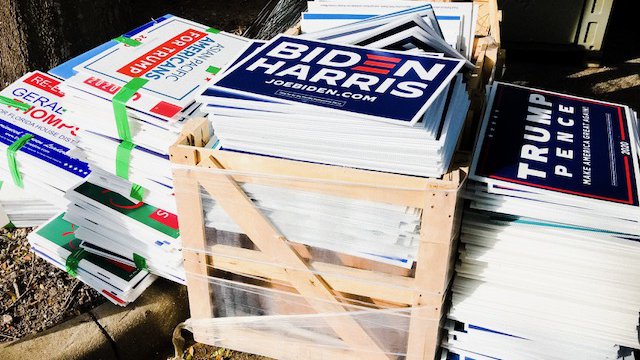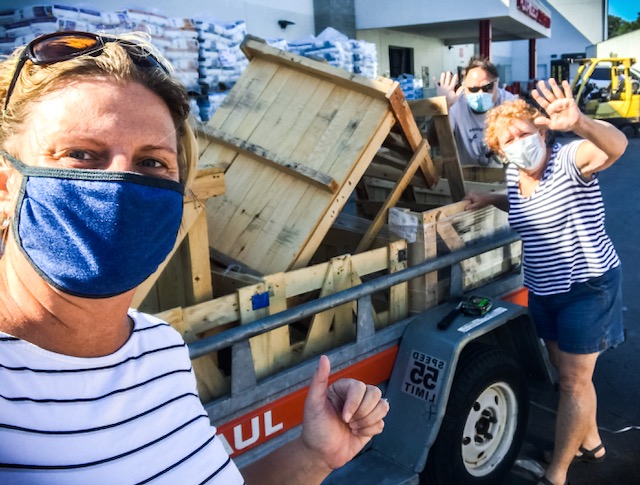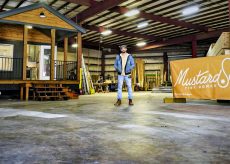ReThink Your Waste Campaign: Politics to Energy

Nov. 17, 2020 | by Stephen Langford
With the results of the 2020 elections still on the forefront of the majority of our minds, some have recognized that the end, more or less, of this intense, and highly publicized, campaign season offers yet another challenge that needs to be addressed: the responsible disposal of political yard signs.
And it needs to be addressed fast. If too much time passes before local communities and municipalities are offered an alternative, the majority of these signs will likely be tossed into dumpsters, or add to the clogging of recycling facilities via wish-cycling, and in either case, will just wind up being sent to landfills.

However, less than 24-hours after the election was called for Biden and Harris, PGHmedia heard about a ReThink Your Waste campaign in Orlando, Florida, offering several drop off locations throughout the area aimed at diverting these materials, both the plastic signs and metal stakes, from the landfills and having them recycled properly… or as it turns out (spoiler), upcycled.
In hopes of getting this story out and planting the seed in the mind’s of other communities before it’s too late, we reached out to Andrea Ruiz-Haze of Eco Strategies Group, one of the organizations leading this effort, to discuss some of the details about their process.
PGH: So Andrea, political yard signs. How did this come about? Obviously, this is something that is really needed, but this isn’t really something we think about. Everyone’s so caught up in the hectic-ness of elections, and then it’s all over, and we have nowhere to get rid of them. We can’t just throw them in a bin and be done.
ARH: Yeah, so I’ve had this idea for a little bit, and – you know, you’ll have these ideas, and you’ll try to sell them, and I kept thinking people would look. But then as [the election] kept getting closer, and I’m like ‘Hey, hey, we’ve got a solution’, and I wasn’t seeing anyone bite, I decided I’m just going to do this. That’s when I locked arms with the League of Women Voters of Orange County, because they’re all about elections and campaigns, and they even have a Natural Resources subcommittee, which, you know, is all volunteers, but this was something then that the league could get behind. Not only was it about the elections, but this was something that their volunteers could hop on.
You know, I’m not making any money from this, this is all just about doing good for the planet, and I believe as a business owner, we all have to do our part here. I’m not sure there’s a profit to be had here, unless next year the municipalities want to pay me, and then they don’t have to pay code enforcement to go around – maybe there’s a little bit of a revenue model in here somewhere – but in the end, it’s just a great thing to be doing for the little bit of cost that’s been associated with it so far.
PGH: When was it that you actually started trying to put this together?
ARH: Oh… about three weeks ago (laughs).
PGH: In three weeks you put this together? How did that happen? Was it just something that people just started hopping on board with once you got the ball rolling?
ARH: I think this is where it’s worked well for me as a local organizer and community leader. The municipalities were not able to accommodate and adapt so quickly, but where I can come in, provide that infrastructure and then create a couple of marketing pieces – flyers – that immediately allowed the municipalities to say, ‘Yep, great. We’ll get behind this.’ Then they were able to use their platforms, their communication, which gave extra credibility, and of course, once local media gets in on it… Boom… All of a sudden, I think we must have over 10,000 – 15,000 signs by now, and just in the last couple of days, which is great. Cities typically don’t want to not be part of a press release like this.
PGH: How many stations are set up? What kind of numbers are you expecting?
ARH: We have five collection stations. We were hopeful for more, but in the last hour, a couple just didn’t happen, and at that point… A day after the election, I was like, ‘Okay, let’s just focus on the five. Hey, nobody else is doing it. So let’s do it.’
And we have a solid plan now that we can launch next election cycle, especially since we’ve had other municipalities than I’ve spoken with – people in Sarasota, Brevard, Seminal, Volusia. Again, these are municipalities or cities in Florida. They’re very eager, they recognize the amount of litter and nuisance these signs bring really starting the day after election day. So, yeah, others have contacted me to say, ‘Hey, how can we do this?’ And I said, ‘Look, if you wanna do this and you can get it done, and you’ve still got signs out there, go for it.’

More the better, right?
Our original goal was 20,000 signs by November 22, so the last pick up will be November 23, but there have been other county organizations and residents bringing hundreds sometimes thousands of signs in a trailer and dropping off at these locations. People just seem so eager and excited that there’s actually something that can be done with these. You know, while we did not encourage people to drive and spend their money on travel and mileage, that just shows how committed people can get behind a program that’s solid and that they know is something happening for the better of society and for our environment. Again, all this is on volunteer capacity, everybody’s taking it upon themselves to do this, but this is where I believe even next year, for our next election cycle, I’m definitely going to be launching this program again, and then I’ll have more time to put something together that’s even more extensive than what we’ve got offered right now.
PGH: You mentioned the League of Women Voters, but who else is involved? Any other organizations?
ARH: Sure, so Eco Strategies Group, which is my firm, and then we’re also working with Ideas for Us. They are providing some volunteers who are staffing some of the collection locations, and so, basically, we have all these volunteers who are going around just once a day-managing and making sure things stay organized.
PGH: And then, the big question, where are these materials going after collection?
ARH: Well, we have a few nonprofits that want some of the metal stakes, but the bulk of them will be going to a local scrap metal facility. We’ll get back some money to help offset the costs of providing the crates and marketing materials, as well as the vehicle we’ll have to get on collection day to do the transfer, but maybe only a couple hundred dollars.
The signs, on the other hand, will be going to a facility in Plant City called NuCycle Energy, where they’ll be used to create these fuelcubes, which are used as an alternative to fossil fuels and have a fraction of a percent of the carbon emission associated with it compared to fossil fuels. It’s actually a really cool program where they take various forms of waste – no organics, and just the dry stuff – and they create this specific blend that is helping a lot of other corporations with their diversion rates and getting out of the landfills. I think, at least in the interim, this is allowed, and I think eventually some companies will still need to get back towards their recycling targets, but this certainly provides an opportunity, especially for companies like Cemex and others that are wanting to get off fossil fuels.
You know, if I hadn’t gone there and done a tour, we probably would have looked to shred the plastic into pellets and then sell that off to a local plastics company, but that would have taken a lot more work and probably would have been a little bit more costly, too. But, honestly, they are offering a solution to an alternative fuel source, and seeing it in person is completely different… You know, being able to see it first hand… And there is a right mix to making this, you can see that on their tipping floor. It’s a huge, probably 100,000 square foot, might even be bigger, facility with… It’s got a ceiling on it, you know, HVAC, that purifies the air… But on their tipping floor there are all these different piles of commodities. So imagine this massive bucket loader going around and picking up different aggregate materials and feeding it to the shredder, and that’s what allows this system to have a good blend. Almost, I think of it as a baker baking a cake – you have to have all the right ingredients for it to come out correctly. It can’t just be that all of a sudden you just load in everything that was just cardboard, and then later you come in with all the plastics. It has to have this mixture because they have to have a consistency in their product – because that’s what Cemex and the others are relying on.

_________________
Interested in organizing a yard sign collection in your area? Try reaching out to some of your local non-profits and/or local businesses. Others in your community would probably be more than willing to participate, if they don’t know of any already.



